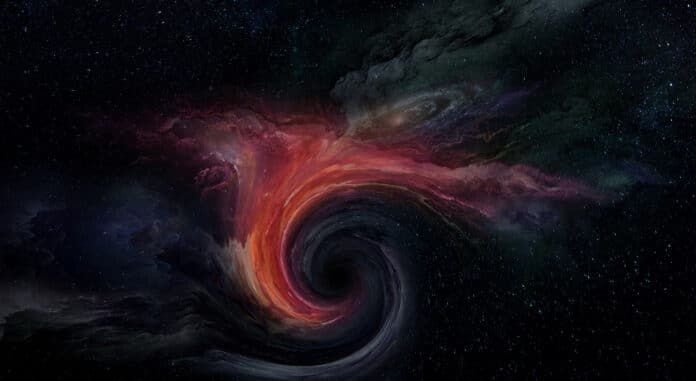There is evidence of a rogue Supermassive black hole ripping through space and interacting with the circumgalactic medium, according to researchers from Canada, Australia, and the United States (CGM.) The giant is also causing shock waves and starting star formation.
Identifying runway SMBHs is of obvious interest but difficult. There are several ways for a supermassive black hole (SMBH) to escape from the center of a galaxy. The first step is always a galaxy merger, forming a binary SMBH. If a third SMBH reaches the galaxy’s center before the binary merges, a three-body interaction can impart a large velocity to one of the SMBHs leading to its escape from the nucleus.
However, despite their theoretical foundations, it is challenging to locate these rogue SMBHs. In 2021, astronomers discovered one of the top contenders, 230 million light-years distant.
The authors saw unusual movement and speed, indicating a recent disruption. However, they could not determine whether they had witnessed a gravitational wave recoil event, a double black hole system, or an ongoing galaxy merger.
There are a few methods by that astronomers can spot a runaway SMBH. The simplest method is if the hole can be recognized by its luminosity as an active galactic nucleus that absorbs the material.
Scientists noted, “For such objects, the presence of an SMBH is not in doubt, but it can be difficult to determine whether they are ‘naked’ black holes or the nuclei of merging galaxies.”
The star mass that the rogue hole pulls behind it is another way. When an SMBH is ejected, some stars are drawn along by its powerful gravitational force. Yet, the lack of an AGN’s luminosity makes it challenging to distinguish the hole and its star companions at a distance.
A suspected rogue SMBH’s impact on diffuse gas in the circumgalactic medium (CGM) as it passes through it is a third technique for astronomers to identify it.
Scientists noted, “The interaction of a runaway supermassive black hole with the CGM can lead to the formation of a wake of shocked gas and young stars behind it. Their paper reports the serendipitous discovery of a linear feature in images from Hubble’s Advanced Camera for Surveys that could be one of these wakes.”
An SMBH creates a shock front and a substantial wake as it passes through ionized hydrogen in the CGM. Clouds of shocked gas can cool and form stars that resemble knots in the trail in the aftermath. Three of the linear feature’s knots were examined, and the scientists determined their ages and metallicities.
According to theory and simulation, the youngest stars formed in the wake should be less than 30 million years old. The three knots fall within the age range suggested by models, according to measurements of their attributes made by the researchers. Moreover, their metallicities and dust contents fall within the range.
If the host galaxy ejected an SMBH, the galaxy should show signs of disruption. SMBHs are extraordinarily massive, and that much mass can’t move through a galaxy without shaping it. The team examined the galaxy that spawned the rogue SMBH and found its morphology disrupted.
Scientists noted, “There is, however, another possible explanation for the linear feature. It could be a black hole jet rather than a rogue SMBH. Under the right conditions, black hole jets can also shock gas in the CGM, leading to star formation. There are two well-studied nearby examples of jets triggering star formation. One of them is called Minkowski’s Object.”
“The black hole jet explanation is possible, but they say it has too many problems. Visible emission lines aren’t a property of black hole jets, and there’s no evidence of nuclear activity. There’s also a problem with morphology. A more serious issue is that the morphology of the feature does not match simulations or observations of jet-induced star formation.”
“They settle on a runaway SMBH as the best explanation for the data and observations.”
“The line ratios, colors, and the overall morphology are consistent with an ejected SMBH moving through the CGM at high speed while triggering star formation.”
“Locating the black holes would be incontrovertible evidence for this conclusion. The ‘smoking gun’ evidence for this scenario would be the unambiguous identification of the black holes themselves.”
“These are candidates for ‘hyper compact stellar systems,’ SMBHs enveloped in stars and gas that escaped with them.”
“Deeper data, for instance, from the JWST NIRSPEC IFU, may show the expected broad, highly red- or blueshifted emission lines of ionized gas bound to the black holes. Those data could also spatially resolve flows, shocks, and star formation near A.”
“Looking ahead, the morphology of the feature in the HST images is so striking that it should not be too difficult to find more examples if they exist. Future data from the Nancy Grace Roman telescope can be searched with automated algorithms.”
Journal Reference:
- Pieter van Dokkum et al., A candidate runaway supermassive black hole identified by shocks and star formation in its wake, arXiv (2023). DOI: 10.48550/arxiv.2302.04888
